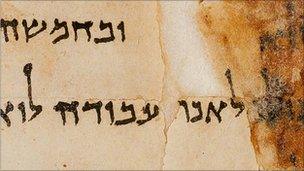Google helps put Dead Sea Scrolls online
- Published

The 1,200 megapixel images capture extremely small details on the scrolls.
Ultra-high resolution images of several Dead Sea Scrolls are now available on the web, after Google helped digitise the ancient texts.
The search firm lent its expertise in scanning documents to the Israel Museum in Jerusalem.
Both amateur and professional scholars will now have access to 1,200 megapixel images.
Five scrolls have been captured, including the Temple Scroll and Great Isaiah Scroll.
Ardon Bar-Hama, a noted photographer of antiquities, used ultraviolet-protected flash tubes to light the scrolls for 1/4000th of a second. The exposure time - which is much shorter than a conventional camera flash - was designed to protect the scrolls from damage.
The Dead Sea Scrolls were discovered between 1947 and 1956 inside 11 caves along the shore of the Dead Sea, East of Jerusalem.
As well as containing the oldest copies of many biblical texts, they also include many secular writings relating to life in the 1st and 2nd Centuries AD.
The texts are generally written on papyrus or parchment, and in many cases only small fragments remain.
Scrolls are:
The Temple Scroll: lays out plans for the construction and operation of the Temple. Written on thin animal skin.
The War Scroll: one of the first scrolls to be found. The War Scroll outlines an end of days time where the the archangel Michael leads the "Sons of Light" against the "Sons of Darkness".
The Community Rule Scroll: also known as the manual of discipline, the scroll outlines a comprehensive guide for the "community", whose identity remains uncertain, although is believed to be the Jewish sect the Essenes.
The Great Isaiah Scroll: the best preserved of all the biblical scrolls, it contains a Hebrew version of the book of Isaiah.
The Commentary of Habakkuk Scroll: interprets the first two chapters of the book of Habakkuk.
Google has assisted in digitising a large number of historical documents, including , which brings together high resolution versions of many classic paintings from galleries around the world.
It has also created Google Earth tours of , and digitised documents from the .
However, the company has run into difficulties with its plan to scan all of the world's books.
It has already paid out $125m to settle a claim for copyright infringement by the US-based Authors Guild.
More recently, a group of writers from the UK, Australia and Canada initiated a legal action against five US universities that had been compiling an online library of texts scanned by Google.
The so-called "orphaned works" are out of print and their authors cannot be traced.
- Published13 September 2011
- Published21 October 2010